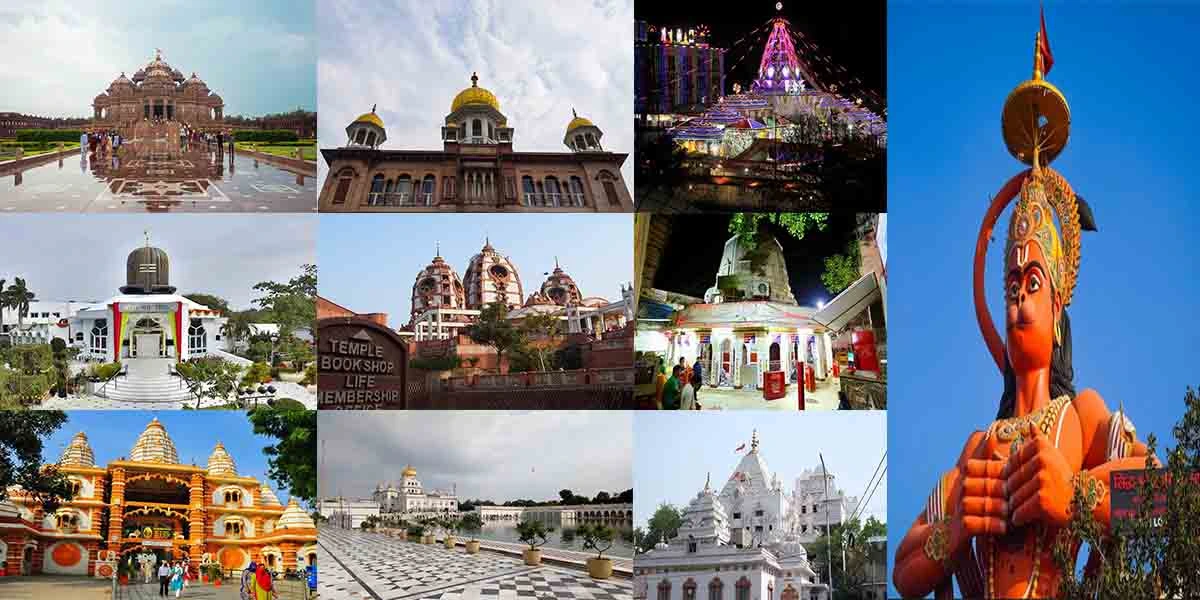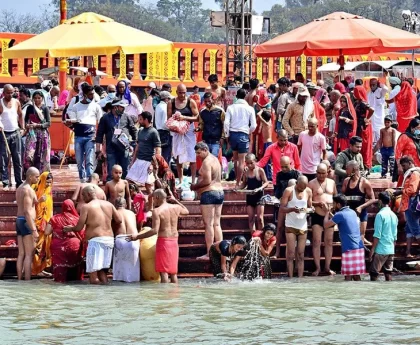Famous Temples In Delhi, the capital city of India, is home to several ancient and revered temples that attract both locals and tourists.
Here are some famous temples in Delhi that you must visit:
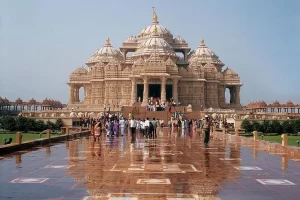
Akshardham Temple, also known as Akshardham Mandir, is a Hindu temple complex located in Delhi, India. It is one of the largest and most popular temples in the world and a significant landmark in Delhi.
Website: https://akshardham.com/
Here are some key details about Akshardham Temple:
- Location: Akshardham Temple is situated on the banks of the Yamuna River in the eastern part of Delhi. Its address is Noida Mor, Pandav Nagar, New Delhi, Delhi 110092, India.
- Construction: The temple was built by the Bochasanwasi Shri Akshar Purushottam Swaminarayan Sanstha (BAPS) organization. The construction of the temple complex began in 2000 and was completed in 2005. It was inaugurated on November 6, 2005.
- Architecture: Akshardham Temple showcases a blend of traditional Indian architecture and modern technology. The main temple complex is constructed using pink sandstone and features intricate carvings, ornate pillars, and beautiful domes.
- Main Attractions: The temple complex comprises various attractions that highlight Indian art, culture, and spirituality. Some of the main attractions include:
- Mandir: The main temple is dedicated to Bhagwan Swaminarayan and showcases his life through exhibitions, audio-animatronics shows, and light and sound displays.
- Boat Ride: Visitors can enjoy a boat ride called “Sahaj Anand Water Show,” which depicts an ancient Indian story using colorful fountains, lasers, and multimedia effects.
- Exhibitions: There are several exhibitions, such as the Hall of Values, Sahajanand Darshan, and Neelkanth Darshan, that showcase Indian history, values, and spirituality.
- Gardens: The temple complex has beautifully landscaped gardens with fountains, sculptures, and lush greenery.
- Entry and Timings: Entry to Akshardham Temple is free, but there may be charges for some of the attractions inside. The temple is open from Tuesday to Sunday, and the timings are generally from 9:30 AM to 6:30 PM. However, it’s always recommended to check the official website or contact the temple authorities for the most up-to-date information regarding timings and entry rules.
- Guidelines: To maintain the sanctity of the temple, certain guidelines are in place. Photography, mobile phones, and other electronic devices are not allowed inside the temple complex. It is advisable to dress modestly and carry minimal belongings while visiting.
Akshardham Temple in Delhi is not only a place of worship but also a center of cultural and spiritual enlightenment. It attracts millions of visitors every year who come to experience its grandeur, learn about Indian culture, and find solace in its serene atmosphere.
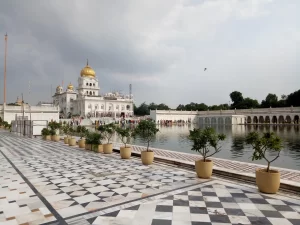
Bangla Sahib Gurudwara, also known as Gurudwara Bangla Sahib, is one of the most prominent Sikh gurudwaras located in Delhi, India. It holds significant religious and historical importance in Sikhism and is visited by thousands of devotees and tourists every day.
Here are some key details about Bangla Sahib Gurudwara:
- Location: The gurudwara is situated in the heart of Delhi, near Connaught Place, on Ashok Road.
- History: Bangla Sahib Gurudwara was originally a bungalow (bangla) belonging to Raja Jai Singh, a Mughal Emperor. It is said that the eighth Sikh Guru, Guru Har Krishan, resided here during his stay in Delhi in the 17th century. The gurudwara was later built to commemorate his visit and serve as a place of worship.
- Architecture: The gurudwara features a magnificent white-marbled structure with golden domes, which gives it a distinctive and grand appearance. The main prayer hall, known as the Diwan Hall, is a spacious and serene area where the Sikh holy book, Guru Granth Sahib, is kept and recited.
- Sarovar (Pool): Bangla Sahib Gurudwara is known for its Sarovar, a holy water tank, which is considered sacred by the Sikh community. Devotees take a dip in the Sarovar as it is believed to have healing properties and spiritual significance.
- Langar: One of the notable aspects of Bangla Sahib Gurudwara is its Langar, a free community kitchen that serves food to all visitors regardless of their religion, caste, or social status. It is one of the largest community kitchens in India and symbolizes the Sikh principle of equality and selfless service.
- Services and Activities: Apart from regular prayers and religious ceremonies, the gurudwara also offers various community services. Medical facilities, educational programs, and accommodation for visitors are provided by the gurudwara management.
- Visiting Bangla Sahib Gurudwara: The gurudwara is open to visitors of all faiths and is accessible throughout the year. It is advisable to cover your head, remove footwear, and dress modestly when visiting, as a mark of respect for Sikh customs.
Bangla Sahib Gurudwara is not only a place of worship for Sikhs but also an important landmark in Delhi that represents the rich heritage and culture of Sikhism.
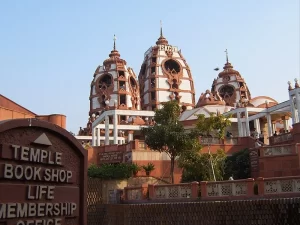
ISKCON Temple, also known as Sri Sri Radha Parthasarathi Mandir, is a prominent Hindu temple located in Delhi, India. It is one of the most popular and frequently visited temples in the city.
Here are some key details about the ISKCON Temple in Delhi:
- Location: The ISKCON Temple free fo is situated in the East of Kailash area of South Delhi. The exact address is Hare Krishna Hill, Sant Nagar, East of Kailash, New Delhi – 110065, India.
- Deities: The main deities worshipped at the ISKCON Temple in Delhi are Lord Krishna and His consort Radha. The temple also houses idols of other deities like Lord Rama, Lord Hanuman, and Lord Narsimha.
- Architecture: The temple follows the traditional Vedic architectural style. It features a beautiful white marble structure with intricate carvings and domes. The temple complex is spread over a large area and includes gardens, fountains, and a museum.
- Activities: The ISKCON Temple in Delhi organizes various activities and events to promote spiritual and cultural awareness. Daily arati (worship ceremonies), kirtans (devotional singing), and discourses on the Bhagavad Gita and other scriptures are held. The temple also celebrates major Hindu festivals like Janmashtami and Radhashtami with great enthusiasm.
- Prasadam: The temple is known for its prasadam (sanctified food) distribution. Visitors can relish delicious vegetarian meals and snacks offered as prasadam in the temple’s dining hall. The food is prepared with utmost cleanliness and devotion.
- Bhaktivedanta Book Trust (BBT): The ISKCON Temple in Delhi houses a branch of the Bhaktivedanta Book Trust, which is responsible for publishing and distributing books related to Vaishnava philosophy, spirituality, and culture.
- Outreach and Charitable Initiatives: ISKCON Delhi is involved in various charitable initiatives. They run educational programs,od distribution projects, and social welfare programs to serve the underprivileged sections of society.
Visiting the ISKCON Temple in Delhi provides an opportunity to immerse oneself in devotional practices, experience Vedic culture, and gain spiritual insights. The temple is open to people of all faiths and welcomes visitors throughout the year.
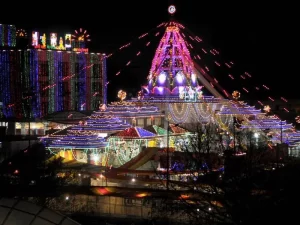
Jhandewalan Mandir is a famous Hindu temple located in Jhandewalan Extension, Paharganj, New Delhi, India. The full address you provided is: Desh Bandhu Gupta Rd, Block E, Jhandewalan Extension, Paharganj, New Delhi, Delhi 110055.
The temple is dedicated to Goddess Aadi Shakti, and it is one of the prominent religious sites in Delhi. Devotees from all over the city and beyond visit the temple to seek blessings and offer prayers.
Jhandewalan Mandir is especially crowded during Navratri, a nine-day festival dedicated to the worship of Goddess Durga, when many devotees gather to celebrate and seek blessings.
Please note that my knowledge is up to September 2021, and there might have been changes or updates since then. If you plan to visit the temple, it’s always a good idea to check for the latest information and timings to make your visit more convenient.
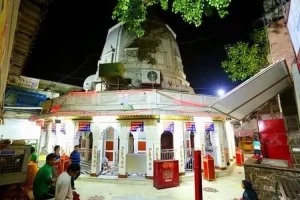
Kalkaji Mandir, also known as the Kalkaji Temple, is a famous Hindu temple located in the Kalkaji area of South Delhi, India. It is dedicated to the Hindu goddess Kali, who is considered a form of the divine mother. The temple is one of the oldest and most revered temples in Delhi.
Here are some key features and information about Kalkaji Mandir:
- Architecture: The temple has a unique and modern architectural design. It is built in a hexagonal shape with a white facade. The main sanctum sanctorum houses the idol of Goddess Kali, adorned with flowers and ornaments.
- Importance: Kalkaji Mandir holds great religious significance among the devotees. It is believed to be one of the 52 Shakti Peethas (holy abodes of the goddess) in Hindu mythology. The temple attracts a large number of devotees, especially during the Navratri festival.
- Navratri Celebrations: The Navratri festival is a major celebration at Kalkaji Mandir. It lasts for nine nights and is dedicated to Goddess Durga. During this time, the temple is beautifully decorated, and special prayers, devotional singing, and dance performances take place.
- Accessibility: Kalkaji Mandir is easily accessible by various modes of transportation. The nearest metro station is Kalkaji Mandir Metro Station, which is on the Violet Line of the Delhi Metro. Buses and auto-rickshaws are also available for reaching the temple.
- Other Temples: In the vicinity of Kalkaji Mandir, there are other temples and religious sites worth visiting. Some notable ones include the Bahai Lotus Temple, ISKCON Temple, and Sai Baba Temple.
- Facilities: The temple complex provides basic facilities such as shoe stands, drinking water, and washrooms for the convenience of visitors. There are also shops nearby where you can purchase religious items, prasad (offerings), and souvenirs.
Visiting Kalkaji Mandir can be a spiritually enriching experience, and it is a popular destination for devotees seeking the blessings of Goddess Kali.
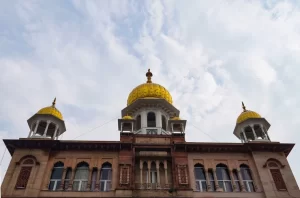
Sheesh Ganj Gurudwara, also known as Gurudwara Sis Ganj Sahib, is a historic Sikh gurudwara located in Delhi, India. It holds great religious and historical significance in Sikhism and commemorates a significant event in Sikh history.
Here are some key details about Sheesh Ganj Gurudwara:
- Location: The gurudwara is situated in the Chandni Chowk area of Old Delhi, near the famous Red Fort and Jama Masjid.
- History: Sheesh Ganj Gurudwara marks the site where the ninth Sikh Guru, Guru Tegh Bahadur, was martyred in 1675. Guru Tegh Bahadur sacrificed his life to protect the religious freedom and rights of Hindus who were facing persecution under the Mughal Emperor Aurangzeb. The gurudwara was built to honor his martyrdom.
- Architecture: The gurudwara features a beautiful architectural design that reflects Sikh traditions. It has a large complex with a central courtyard and a main prayer hall, where the Guru Granth Sahib, the holy scripture of Sikhism, is placed. The gurudwara has a distinctive Sikh flag, known as the Nishan Sahib, flying atop a tall flagpole.
- Sarovar (Pool): Sheesh Ganj Gurudwara has a sacred sarovar, a water tank used for ritualistic bathing and purification. Devotees often take a dip in the sarovar before entering the gurudwara as a symbolic act of cleansing and spiritual devotion.
- Langar: Similar to other Sikh gurudwaras, Sheesh Ganj Gurudwara also serves langar, a free community kitchen where devotees and visitors are offered a simple vegetarian meal. The langar promotes equality and the spirit of seva (selfless service).
- Religious Significance: The gurudwara is of immense importance to Sikhs as it commemorates the martyrdom of Guru Tegh Bahadur, who is revered as a martyr and spiritual leader in Sikhism. It serves as a reminder of the sacrifices made for the freedom of religion and the protection of human rights.
- Visiting Sheesh Ganj Gurudwara: The gurudwara is open to visitors of all faiths and is accessible throughout the year. Visitors are required to cover their heads, remove footwear, and dress modestly as a mark of respect for Sikh customs and traditions.
Sheesh Ganj Gurudwara stands as a significant historical and religious site, attracting devotees, tourists, and history enthusiasts who come to pay their respects and seek spiritual solace.
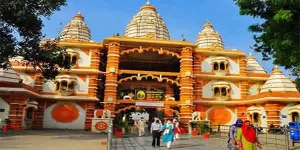
Shree Sheetla Mata Mandir is a famous Hindu temple located in Delhi, India. It is dedicated to the goddess Sheetla Mata, also known as Mata Bhagwati or Masani Mata. The temple is situated in the village of Gurgaon, near the Delhi-Gurgaon border, in the state of Haryana, which is adjacent to Delhi.
Sheetla Mata Mandir is a significant pilgrimage site, especially for people seeking the blessings of the goddess for the protection and well-being of their families, particularly from diseases and illnesses. Devotees believe that worshipping Sheetla Mata helps alleviate various health-related issues and grants relief from viral infections.
The temple attracts a large number of devotees throughout the year, with a significant surge in visitors during the Hindu festival of Sheetla Ashtami, which is celebrated with great fervor and devotion. Devotees often offer prayers, flowers, and coconut at the temple, seeking the goddess’s blessings.
As of my knowledge cutoff in September 2021, Shree Sheetla Mata Mandir in Delhi remained a popular destination for devotees. However, for the most up-to-date and accurate information, it is advisable to check with local sources or official websites for any changes or developments regarding the temple.
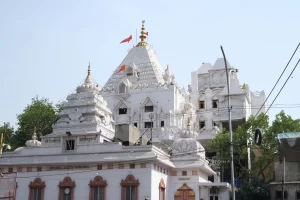
Shri Gauri Shankar Mandir is a famous Hindu temple dedicated to Lord Shiva and Goddess Parvati. While I don’t have information about every specific temple with that name, there are several well-known temples across India that bear the name “Shri Gauri Shankar Mandir.” One prominent temple with this name is located in Delhi, India.
The Shri Gauri Shankar Mandir in Delhi is situated in the Chandni Chowk area of Old Delhi. It is believed to be one of the oldest temples dedicated to Lord Shiva in the city. The temple is particularly known for its unique lingam (a representation of Lord Shiva) made of an 800-year-old black marble carved from a single stone. The lingam is encased in a marble representation of a female organ, symbolizing Goddess Parvati.
Devotees visit the Shri Gauri Shankar Mandir to seek blessings from Lord Shiva and Goddess Parvati. The temple is especially popular among Shiva devotees, who often offer prayers, perform rituals, and make offerings of flowers, fruits, and coconuts.
It’s important to note that there may be other temples with the same name in different locations, as the name “Shri Gauri Shankar Mandir” signifies the divine union of Lord Shiva (Gauri Shankar) and Goddess Parvati.
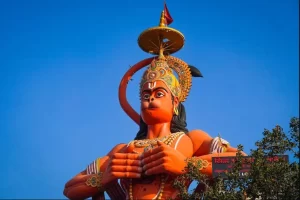
The Pracheen Hanuman Mandir in Karol Bagh is a famous temple dedicated to Lord Hanuman, located in the Karol Bagh area of New Delhi, India. It is one of the oldest Hanuman temples in the city and holds great religious significance for devotees.
The temple is believed to have been established in the year 1724 and has a rich history associated with it. It attracts a large number of devotees, especially on Tuesdays and Saturdays, which are considered auspicious days for Lord Hanuman.
The Pracheen Hanuman Mandir is known for its beautiful architecture and peaceful ambiance. The main deity of the temple is Lord Hanuman, who is revered as a symbol of strength, devotion, and loyalty in Hindu mythology. The idol of Hanuman in the temple is said to be self-manifested (swayambhu) and is believed to have healing powers.
The temple complex also houses idols of other deities, including Lord Rama, Sita, Lakshmana, and Lord Shiva. The walls of the temple are adorned with vibrant paintings depicting various scenes from the Hindu epics like Ramayana and Mahabharata.
Devotees visit the temple to seek blessings, offer prayers, and perform rituals. The temple hosts special events and celebrations during Hanuman Jayanti (the birthday of Lord Hanuman) and other significant festivals dedicated to Lord Hanuman.
The Pracheen Hanuman Mandir is easily accessible by road and is located near the Karol Bagh metro station, making it convenient for devotees and visitors to reach the temple. It remains open from early morning till late evening, allowing devotees to visit and pay their respects throughout the day.
Please note that the information provided is based on the knowledge available up to September 2021. It’s always a good idea to double-check the timings and any updated information before planning a visit to the Pracheen Hanuman Mandir
If you don’t like this article/post please share your feedback.

